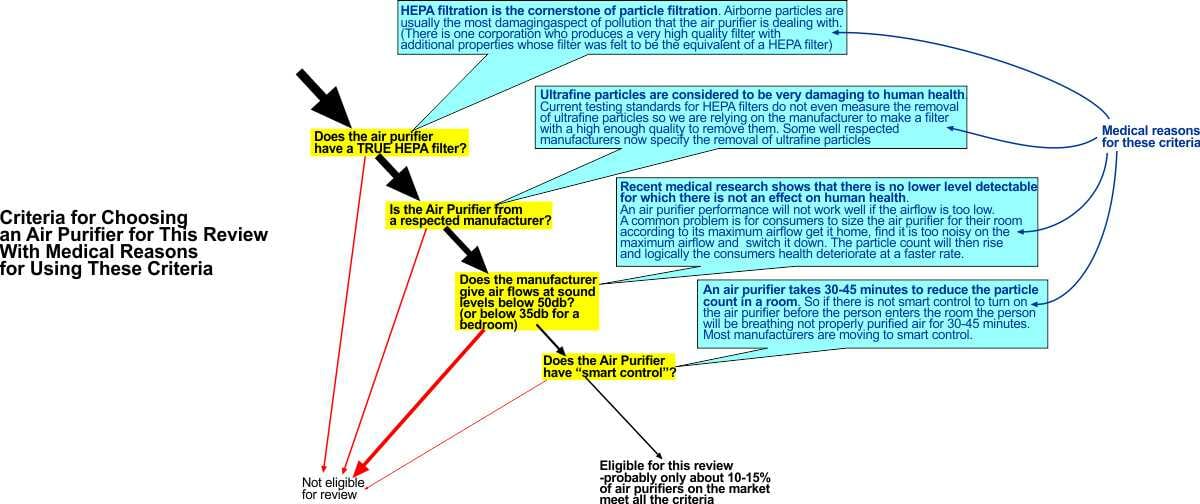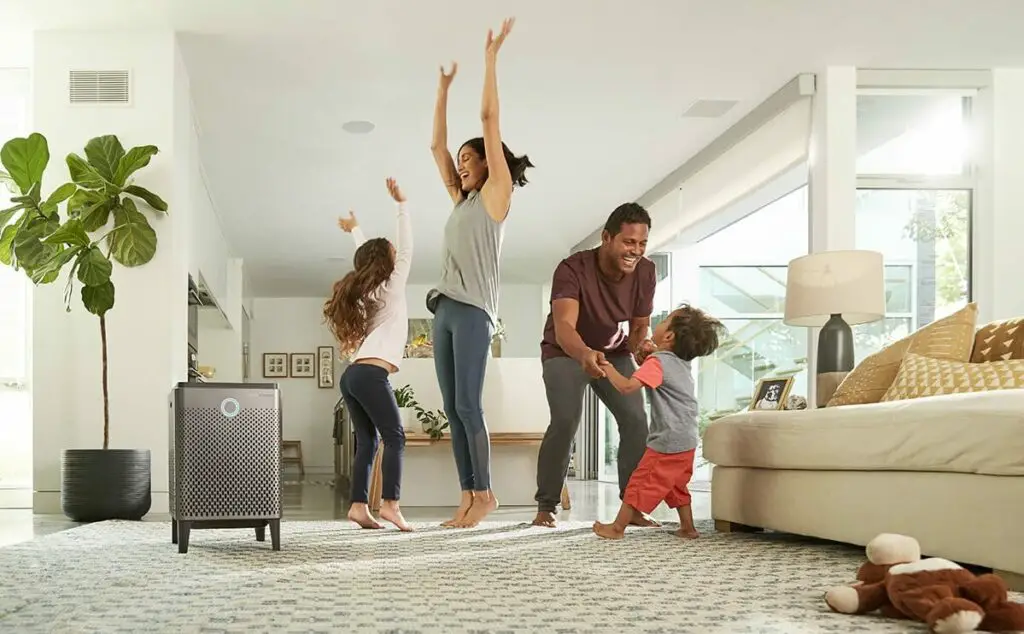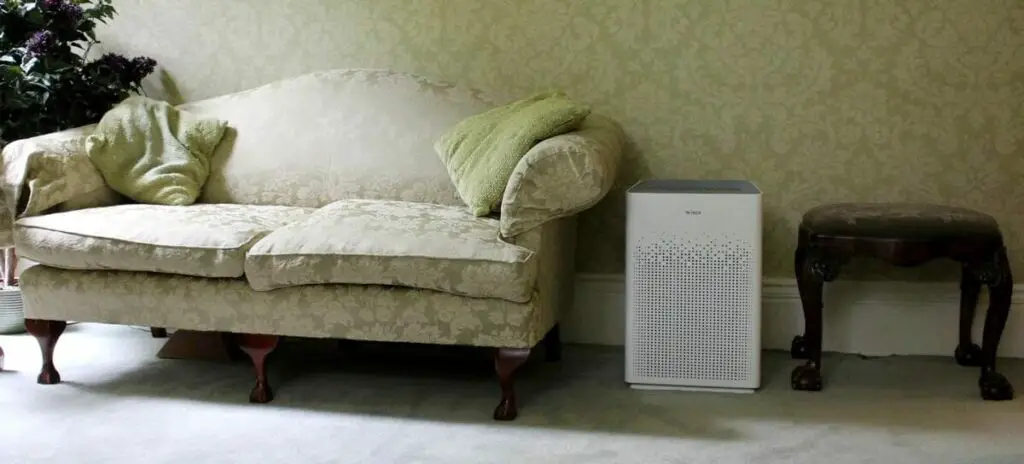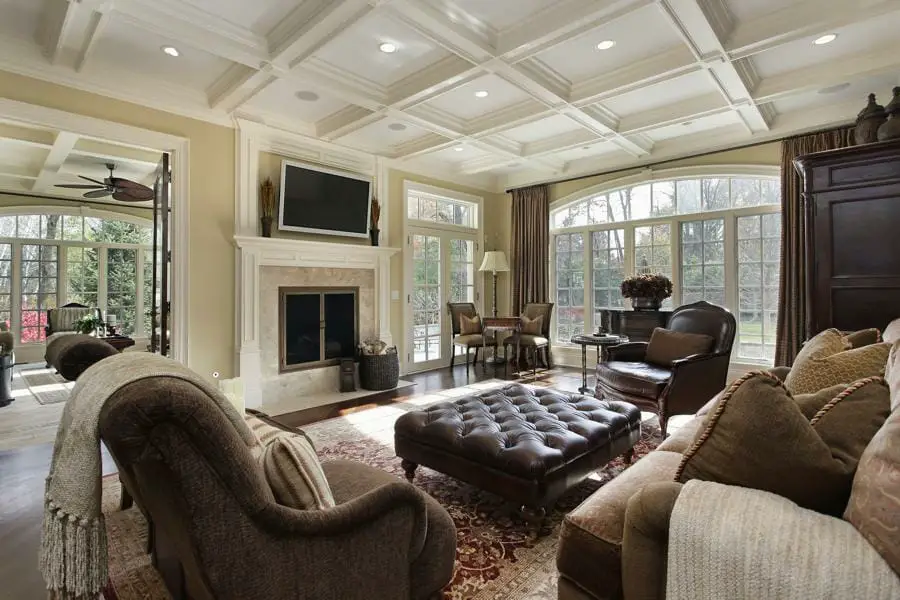Noisy air purifiers are annoying, especially when trying to get to sleep. They are also a health hazard as people switch them down when trying to get to sleep because of the noise and then no longer have adequate air purification. I should know because I made this mistake! You can avoid this by picking the best air purifier for a bedroom on the market.
The best air purifier for a bedroom is the Coway 300S or the Coway 400S depending on the bedroom size. They are the quietest air purifiers on the market due to their dual filter design. Dual filters give a large surface area so the air flow can be relatively slow and still purify a large volume of air.
They have the highest airflow per decibel of any air purifier or the market, under 52db. These air purifiers can be used in a new system, which I outline below, to give you quieter air purification than you could get without using the system.
We are fortunate that we live in an age when air cleaning to improve indoor air quality is so good that we can reduce particle count by 80-90%. However, to be this effective we need to choose the right air purifier and use good technique-
Air Purifier Technique-buying an air purifier with adequate air flow for your room
This is a crucial step in choosing the correct air purifier, as an inadequate air flow will produce inadequate air purification.
The number times a volume of air equivalent to all the air in a room per hour is known as the number of air changes per hour (ACH). There need to be about 5 ACH for the particle count ot be reduced 80%, the minimum that should be achieved by an air purifier according to the EPA. So your air cleaner needs to have a clean air delivery rate, the amount of clean air it produces each minute to provide 5 air changes per hour for your room.
You can estimate the CADR rating that you will need for your room from the following EPA table-

This table assumes bedroom ceilings 8 feet high, if yours are higher or you would prefer to use a calculator you can find one on this page.
The problem is that most manufacturers only give the CADR at the highest fan speed. So like most potential customers, you can only match your needed CADR, to the maximum CADR of an air purifier. So you are likely to buy an air purifier with a maximum CADR only slightly higher than you need. What else are you to do?
Most air purifiers are intolerably noisy on their highest setting. So you will naturally switch the fan speed down to the next level. This fan speed is likely not to be enough for good air quality in your bedroom as you sized the air purifier to your room using the maximum air flow.
Unless you actually measure the particle count at this lower air flow rate, you may not realise that the airborne particle reduction in your bedroom is only 50%. So you are now breathing in 30% more airborne pollutants than the EPA’s recommendation of an at least 80% reduction. Without realizing it this higher particle count is likely to gradually degrade your health as there is overwhelming evidence that particle count damages human health even at low levels. For further information please see this article.
This must be happening in millions of US homes each day, reviews often mention how quiet the air purifier is on a lower setting. So people are probably often turning them down.
Having a quiet air purifier with a high flow rate means that there will be no need to turn it down onto an ineffective setting, obviously important from a health point of view.
To avoid this problem-
First Find a Noise Level That You Are Happy With for Your Bedroom
There is nothing like excessive noise to prevent us sleeping. So we need to understand how loud an air purifier can be, on their maximum fan speed some are as loud as 68db and most are in the range 50-60db. From the following table you can see how loud that is.
Sound levels for some common sounds within the noise range that air purifiers make-
| Type of Sound | Sound Intensity (db) |
|---|---|
| Vacuum cleaner at 10ft, traffic | 70 |
| Conversation in office/restaurant at 3ft, dishwasher | 60 |
| Quiet Suburb, Conversation at home, Large business office, Dishwasher next room | 50 |
| Bird calls | 44 |
| Library | 37 |
| Quiet rural area | 35 |
| Bedroom at night background noise | 30 |
| Whisper | 20 |
| Silence | 0 |
Please bear in mind that the decibel scale is exponential so relative to a 30db sound a 40db sound will sound twice as loud, a 50db sound four times as loud and a 60db sound 8 times as loud as a sound of 30db.
Human hearing is not uniform we do not hear low frequencies so well but hear higher frequencies like the cry of a baby more strongly. So the frequency of the sound has to be taken into consideration. Air purifiers emit higher pitched white noise. So they can be more noticeable in terms of pitch. However, as it is a constant noise, it is easier to tune out as a background noise.
Also, larger air purifiers tend to emit lower tones which are easier on the ear. This is much as larger string instruments, eg a double base emits lower frequency sounds, whereas smaller string instruments such as a violin emit higher frequency sounds. Similarly, a larger air purifier will tend to emit lower frequency sounds which are not so noticeable to human hearing. The Coway 400S and 300S are both medium to large air purifiers and so emit lower frequency sounds, making any sound they produce easier on the ears.
My experience with air purifiers is that anything above 40db when sleeping or trying to sleep is too much, in general I think that less than 35db is probably a better target for sleep.
A Method for finding an acceptable noise level for you for sleeping
a) Carefully assess your noise tolerance for sleeping
You will need 2 mobile phones one as a noise generator and one for measuring noise level.
- Put one phone where you intend the air purifier to be (as far away from your sleeping position as possible) and get it to generate white or pink noise at a fairly loud level.
- Put the other phone 6 feet away from the air purifier recording the sound level (for some reason air purifiers seem to have their noise levels measured from about 6 feet away).
- Lie down in your bed and see if the noise is too loud. If it is then decrease it until you think that it is about right. If it is quieter than would be alright for sleep increase the volume.
- When you think the noise is about right, lie on the bed and see if you could go to sleep with the amount fo noise that you here.
- If the noise is too loud decrease it slightly and repeat the previous step. Conversely, if it is too quiet, increase the noise level and repeat the previous step.
- Note the sound intensity on the mobile phone recording the sound, this is your acceptable noise level.
b) Or just use a maximum of 35db
Rather than measure your own sound tolerance, which would be best, you may simply accept my ballpark estimate for sleep of a maximum sound level of 35 db or less for sleeping.
You now know your acceptable noise level or have a noise level to aim for which is a great step forward. You also know the size of your room and so what clean air delivery rate you need, and so you can choose an air purifier that will produce this clean air delivery rate at a noise below your acceptable noise threshold. Then you can be sure the air purifier will not be too loud for you.
Here is a diagram of the hack that will enable you to have an air purifier half as loud as you would otherwise have and still have excellently purified air-

Air Purifier Basic Specifications
In addition to noise level before choosing the best air purifier for a bedroom there are some basic specifications-
- Excellent filtration of airborne particles, so you should buy a HEPA air purifier, with a true HEPA filter avoid those with “HEPA like” or “HEPA style”…. filters. HEPA filtration easily removes particles such as airborne allergen, pet hair, pet dander, dust particles, mold spores, airborne bacteria, dust mite and even smoke particles with a very high efficiency. Ultrafine particles in the air can enter our blood streams and have been found in human brains. They are thought to have serious health effects. Some filters are specified to deal with ultrafine particles, my choices the Coway 300S and Coway 400S both deal with ultrafine particles down to 10nm in diameter.
- It should also have a carbon filter as a HEPA filter cannot catch gaseous pollutants. This is because the molecules are too small to be trapped by the filter. The activated carbon removes airborne chemicals, these include volatile organic compounds, which cause odors. So this filter is sometimes referred to as the “odor filter” and can be especially helpful for reducing pet odor.
For additional information please see this article on how air purifiers work.
Of course filter replacement will be necessary and the expense of this can be very different from one air purifier to another. These expenses are outlined below for the air purifiers chosen.
UV light is not essential and indeed, many of the top air purifiers do not have it. It is less effective in HEPA filter because the air passes by the UV light so quickly that there is little time for any micro-organism in the air to be irradiated and destroyed.
Other air purifiers without HEPA filters are not recommended, as they have not been found to be as effective as HEPA filters.
The Best Bedroom Air Purifiers
The choices here represent the best choices of air purifiers from all established manufactures on the market who would give me the noise levels at their machine’s various fan speeds/CADR ratings. This information was needed so that I did not recommend an air purifier that is too noisy for you.
We also need a smart air purifier, for health reasons an air purifier needs to come on 30 minutes at least before you step into the room as explained here. Thus, a schedule for it switching on and off needs to be programmable. So only those air purifiers with smart control or those that could be made smart with a smart plug were considered.
The criteria for choosing the air purifiers for consideration were all backed by health considerations as outlined in this diagram-

This narrows down the list dramatically in a logical way based on health criteria.
You will be used to seeing reviews that offer the “best 8 quiet air purifiers” in reality, there are not 8 roughly equivalent quiet air purifiers. It will not surprise you that in most categories, as in life or an Olympic race, there is almost always a clear winner. Here, it is a surprise that there are 2 joint winners. Compared to these 2 air purifiers, on average other air purifiers on the market are twice as loud for an equivalent air flow so it is not even a close contest!
Incidentally, the “best 8 quiet air purifiers” reviews almost always contain an air purifier with a hidden problem that the review does not point out, and which logically would lead to a considerably higher particle count and so presumably faster deterioration in the health of those buying the air purifier. Some of the choices are simply wrong on the data available.
Anyway here are my choices for best air purifier for a bedroom, after considerable research and obtaining data from the manufacturers which is not on the website or in the manual-
Coway 400S-Very very quiet-28db for a bedroom of 305 sq ft*
This air purifier has an extremely highly specified HEPA filter which deals with ultrafine particles. It is so quiet that it will even purify the air in a room of 300 sq ft at a noise level of 28db, which would feel about half as loud as my maximum sound level for sleep, so this is a very quiet purifier! This would also make the Coway 400S the ideal bedroom air purifier.
It also has massive capability on its higher fan speed settings, for air purification in emergencies such as wildfires.

Specifications
| Filters | |
| HEPA filter | HEPA specified to remove 99.8% of ultrafine particles down to a size of 0.01um |
| Carbon filter amount of carbon (lb) | 1.5 lb so more than most other air purifiers |
| Filter Change HEPA (Particles) | 12 months |
| Filter Change Carbon (Chemicals) | 12 months |
| Airflow | |
| CADR at less than 35db noise | 198 cfm |
| Maximum Room Size (Noise less than 35db*) | 305 sq ft |
| Maximum Room Size (On noisiest setting) | 640 sq ft |
| Smart Control | Yes phone app/Alexa:/Google Home |
| Power | 66 W |
| Weight | 24.7 lbs |
| Dimensions “H x “W x D” | 22.8 x 14.8 x 14.8 |
| Annual Running Cost Electricity ($) | $40 |
| Annual Running Cost Filters ($) | $120 |
| Total Annual Running Cost ($) | $160 |
All the above are approximate and assume running the air purifier for 12 hours per day on the highest setting that keeps the noise below the level specified in db in the table. This is less than or equal to 50db in normal daytime use and 35db for bedrooms.
*Most people will not wish to have the air purifier on a setting louder than about 35db for sleeping in a bedroom-you may wish to have a quieter setting than 35db this is just a ballpark estimate for most people. On the other hand, if your room layout allows you to be much further than 6 feet from the air purifier you may find the noise this machine makes at top speed is alright. The calculations for room size assume that you have 8 foot ceilings and 5 air changes per hour.
Never run an air purifier on auto mode using the inbuilt sensor. These cannot detect ultrafine particles which are damaging to human health, please see this article- How to test the air quality in your home.
Its appearance is generally pleasing, and it comes in black and white. The holes in the grill add some black to the white and soften it. The top is black and as the air purifier is not very tall you will be looking down on a black square in your room.
I sometimes think that there should also be a midrange color option, ideally a light grey like the iQair HealthPro Plus or a matt metallic slightly reflective coating which can reflect other colours in the room. In this way the air purifier would blend in with your decor, not stick out. Both white and black add contrast in a room of intermediate colors, and so the eye is naturally drawn to the air purifier.
Coway 300S-Larger bedroom capability 373 sq ft at a noise of 32db
The smaller partner to the Coway 400S. The second highest airflow per decibel on the market in the reasonable noise range. There is one air purifier that has a higher airflow per decibel but only when it is on its highest setting and making so much noise that it would be impossible to be in the room with it for long.

Specifications
| Filters | |
| HEPA filter | HEPA specified to remove 99.8% of ultrafine particles down to a size of 0.01um |
| Carbon filter amount of carbon (lb) | 1.5 lb so more than most other air purifiers |
| Filter Change HEPA (Particles) | 12 months |
| Filter Change Carbon (Chemicals) | 12 months |
| Airflow | |
| CADR at less than 35db noise | 242 cfm |
| Maximum Room Size (Noise less than 35db*) | 373 sq ft |
| Maximum Room Size (On noisiest setting) | 545 sq ft |
| Smart Control | Yes phone app |
| Power | 57 W |
| Weight | 21.4 lbs |
| Dimensions “H x “W x D” | 21.2 x 13.6 x 13.6 |
| Annual Running Cost Electricity ($) | $40 |
| Annual Running Cost Filters ($) | $120 |
| Total Annual Running Cost ($) | $160 |
Why Both Coways?-an example of a new system
The noise levels at various fan speeds makes each one more suitable for specific room sizes.
The Coway 300S is the ultimate air purifier for bedrooms it will purify the air in a bedroom up to 370 sq ft at a noise level of 32 db whereas the Coway 400S would be twice as noisy for a room of this size at 43db. Most other air purifiers on the market would be twice as noisy again. So for a bedroom of this size, the Coway 300S makes about a quarter of the noise of the average air purifier.

The diagram does not go below 28db as this sound level is virtually inaudible in a room, and should be quiet enough for anyone.
This novel system that I have developed of picking individual speeds for particular room sizes ensures the quietest choice of air purifier for a particular room. It works well for these 2 Coway models, one of these 2 air purifiers depending on room size will give you the quietest possible air purification for your room. In this way one of these two Coway twins will be the best air purifier for your bedroom.
Winix AM90-more cost effective option for bedrooms up to 145 sq ft-Under $200
This is the replacement for the Winix 5500 air cleaner and has the advantage of smart Wi-Fi control. For sleeping, this air purifier can be only be recommended for bedrooms up to 145 sq ft as the noise level to serve a room of this size is 36db.

| Filters | |
| HEPA filter | HEPA 13 filter |
| Carbon filter amount of carbon | Small amount of carbon incorporated into main filter 0.1 lb |
| Filter Change HEPA (Particles) | 12 months |
| Filter Change Carbon (Chemicals) | 3 months |
| Airflow | |
| CADR at 36db | 94 cfm |
| Maximum Bedroom Size* | 145 sq ft |
| Maximum Room Size (On noisiest setting) | 360 sq ft |
| Smart Control | Smart Phone App |
| Power | 65 W |
| Weight | 15.8 lb |
| Dimensions “H x “W x D” | 23.5 x 8.7 x 15.1 inches |
| Annual Running Cost Electricity | $20 |
| Annual Running Cost Filters | $80 |
| Total Annual Running Cost | $100 |
Bedroom Air Purifiers Under $100
There are no really good options unless your bedroom is tiny. For a very affordable air purifier I would recommend the Levoit 200S. The price is great but this air cleaner will only purify the air of a bedroom of 85 sq ft at 35db or 112 sqft at 40db. 40db is really somewhat above my ideal noise level for an air purifier, but if you have the air purifier as far from your ears as possible given the room geometry you will probably find it alright.
How to control your bedroom HEPA air purifier?
As a general rule, it is best to control your air purifier by buying an air quality meter and aiming for the greatest reduction in particle count or pollution that you can achieve. Comparing the particle count or air pollution before switching the air purifier on with that after it has been on for an hour, the EPA recommends an at least 80% reduction. What ever you do, do not let your air purifier control itself, the 7 reasons for this are given here.
Best Bedroom Air Purifier for a Bedroom With a Smoker
On the whole the best air would be the iQair Multigas or iQair HealthPro Plus as they have the largest highest quality activated carbon filters. The activated carbon filters will remove the carcinogenic chemicals that are in cigarette smoke from the room air. These air cleaners are however not very quiet so you would need to think about your noise tolerance for sleep and where in the room you would intend to place the air purifier.
What is the best bedroom air purifier for allergies?
There are two air purifiers that stand out, the Coway 300S and Coway 400S. Any true HEPA air purifier will be able to deal with allergies as a HEPA filter is enough to trap virtually all allergens. These air purifiers have a HEPA filter which is specified to reduce most ultrafine particles and they have great air filtration ability. In addition, they can do all of this very quietly.
What is the best location for an air purifier in a bedroom?
As a general rule the best location for an air purifier in a bedroom is as far away from the bed pillows as possible and 12-18 inches away from the wall. Being as far away from you pillows as possible means that it will be as far from your ears as possible and so the sound level will be as low as possible. The air purifier needs to be 12-18 inches from the wall so that the air it processes joins in with the air currents in the room. Also being further away from the wall will lessen the sound reflected from the wall.
For further information on how to use an air purifier please see this article.
Conclusion
The best bedroom air purifier is either the Coway 400S or the Coway 300S depending on room size and how quiet you wish your air purifier to be (please see diagram above).
Both of these machines have an excellent filtration system which has specifications beyond the true HEPA standard and will effectively reduce airborne particles, including most ultrafine particles. So quite apart from being the quietest air purifiers on the market, they produce the second best specified air quality on the market. The iQar HealthPro Plus produces the best air quality but is much noisier and so not so suitable for bedrooms, I have written a review of it here.
They also both have good activated carbon filters which remove chemical pollutants from the air including odors.
Related Questions
See Also


Best Air Purifier for a Large Room?

Best Air Purifier for a Basement?


